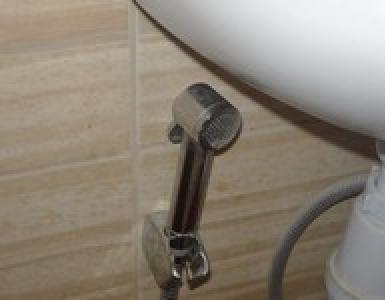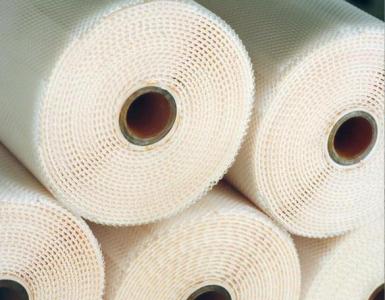Soil layers when drilling wells. What is underground water. Is it possible to clean a small well that has been hammered?
For home and cottage is very important to have water. Some lucky people can connect to centralized water supply, but most have to look for their own source. About how to find water on the site itself, with their own hands and will go further.
Aquifers and their occurrence
The structure of occurrence of rocks is very heterogeneous. Even at one site at a distance of a meter "pie" - the composition of the layers and their sizes - can vary significantly. Because it happens so hard to find water on the site, you have to drill several wells to find a normal aquifer. There are three main aquifers:
The country borders on the north of Syria, in the east with Iraq and Saudi Arabia, in the south - with Saudi Arabia and the Gulf of Aqaba, and in the west - by Israel. In the east - the Syrian desert. The region to the west of Jordan, the so-called Westjordanland, is occupied by hills and high mountains. The deepest parts of the Jordanian marsh, about 213 m below sea level, are located near Lake Tiberias and at an altitude of 408 m below sea level in the Dead Sea, the lowest point on Earth.
Jordan, which forms the border with Jordan in Israel and in the west of Jordan, is the main drainage system in the country. Precipitation usually occurs during the winter months and ranges from 660 mm in the northwest to 130 mm in the far east. Jordan is an absolutely dry country, which must suffer greatly from lack of water.
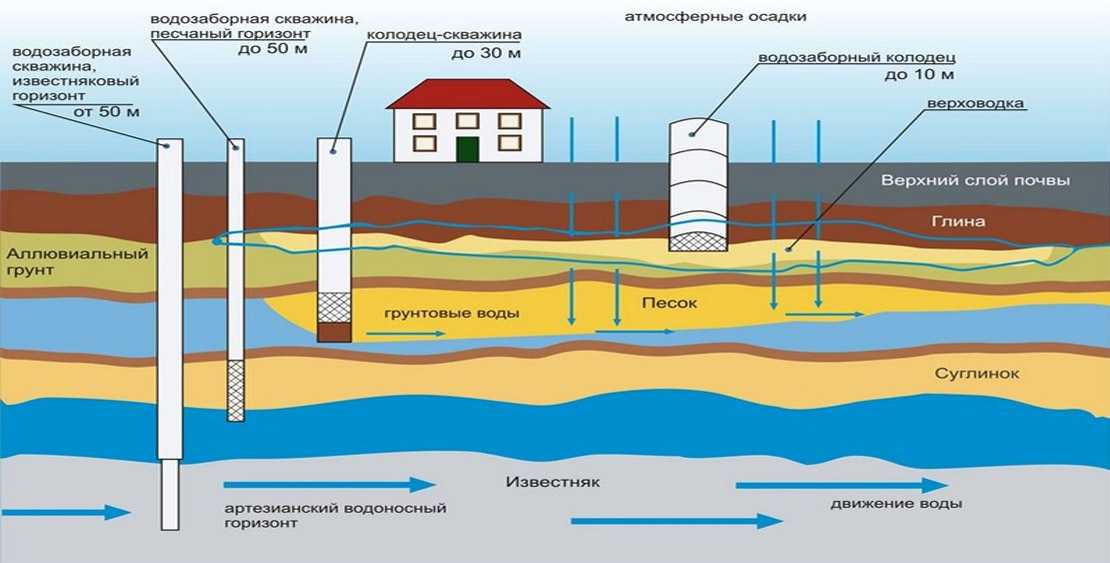
I must say that it is not difficult to find a verkhovodka on the site. Knowing some of the features of vegetation, having checked some points, you determine the location of the water-bearing with a fairly high accuracy.
With the water-bearing sand layer, everything is much more complicated - the depths are serious, it is necessary to focus mainly on the location of wells-wells in the neighbors, well, not some indirect signs.
Location: Lebanon is located in Frontaz and borders on the east and north of Syria, to the south of Israel and to the west among the Mediterranean Sea. Climate: climatic map, precipitation, temperature. The climate of Jordan is continental. It is characterized by large seasonal fluctuations in temperature and precipitation. In January, the coldest month, the minimums below the freezing point, are not unusual.
Location: Syria is located in the Middle East, bordering Turkey in the north, Iraq in the east, Jordan and Israel in the south, Lebanon and the Mediterranean Sea in the west. Topography: Along the Mediterranean coast there is a plain stretching up to 32 km into the interior of the Land. Most of the rest of Syria consists of high mountains, which is divided into the northeast of the Euphrates. Part north of the Euphrates is called the Al-Jazeera Highlands. To the south-east is the Syrian desert.
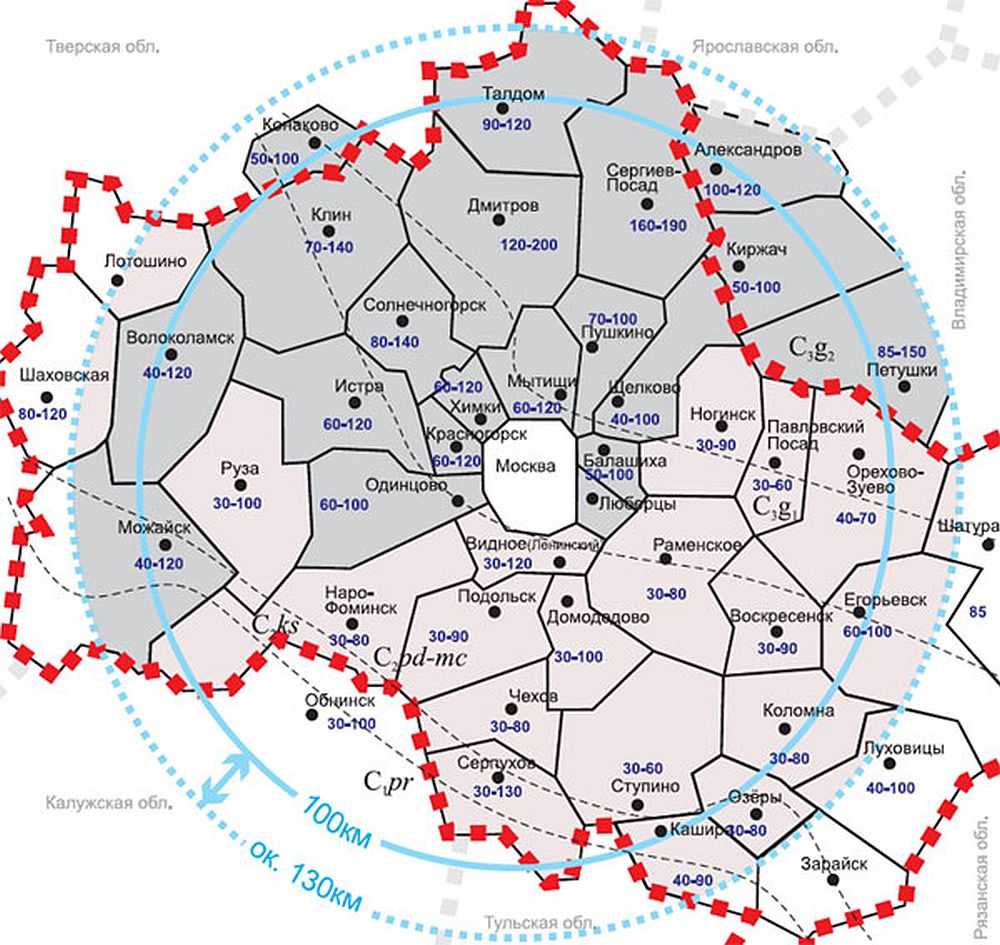
You can find artesian water on the site only with the help of trial drilling. Mapping of aquifers can help. Since 2011 in Russia they are open access (without payment). To get a map of your region, you need to send an application to ROSGEOLFOND. You can do it on their official website, but you can download the forms of the required documents, fill them in and mail them (with the receipt of the receipt).
Euphrates, the longest river in Syria, flows across the country from Turkey in the north to Iraq in the east. The river is a vital source of water for irrigation in Eastern Syria. Regional temperature differences are relatively low. Jordanian and Jordanian basins. Jordan stretches 359 km and goes back to Hermon, a mountain on the Lebanese-Syrian border in the Golan Heights. The river takes water from three spring streams, Hasbani, Dan, Banias and Yarmuk, and also the ground layers of rocks form larger water resources for several states in this region.
How to find water on the site with the help of folk methods
There are many people's ways of finding water on the site. You can believe in them, you can not believe, but on average, the percentage of hit is 70-80%, which is not lower than the "scientific" methods, so it's definitely worth trying. These methods require a certain amount of time and attention, but are free (if you are looking for water on your site yourself), so they can be combined - test several ways, and dig / drill at the point where their testimony converges.
Hasbani originates in Lebanon, Dana in Israel and in Bani in Syria. Spring streams are found just outside the Israeli border. Yarmuk occurs in Syria and forms the Jordanian-Syrian border more than 40 km. Water resources on the surface are also supplemented by approximately 22 underground basins that flow underground in Israel, Palestine and Jordan. Renewable water resources of rocks that feed on rainwater are very important. There are 3 large aquifers, and although the three mountain aquifers are the main source of water in the west of Jordan, they are used by Israel and only 17% by Palestine.
Pay attention to plants
This paragraph is meaningful only if the site is not developed, but "populated" by wild plantations. By where and which plants grow quite accurately you can determine the depth of the water.

All that is necessary - to walk around the site, to see where it is growing, near the found plants to put up pegs, on which you can indicate the possible depth of the water. The table shows a list of plants by which it is possible to determine the presence of water at a particular depth.
The remaining 12% are not used yet. Historical: in order to understand how the political situation of Israel with other states, we must first consider the history of the state. The history of the Jewish state actually begins before its foundation. After the long immigration of Jewish settlers in Palestine, which was previously a British colony, was the result of the persecution of Jews in Europe by Hitler and the idea of the existence of a Jewish state that always existed against itself.
Since the League of Arab States considered itself a defender of the Palestinians, Israel was declared war on the next day by Transjordan, Syria, Lebanon, Iraq and all who considered themselves Arab leaders. Israel had to accept large losses of territory, but, finally, with the support of American resources, was able to defend itself. Result: Jerusalem was divided into the Jordanian and Israeli half, the Israeli capital Tel Aviv was only 18 kilometers from the next Jordanian military post.
| Plant - indicator | Depth of occurrence of perchage |
|---|---|
| Rogoza, wild rosemary, birch fluffy | 0 to 1 m |
| Sandy reeds, buckthorn, wild boar, | 1 - 3 m |
| Reed, loch, sarsazan, common spruce, blackberry, raspberry, poplar black | up to 5 m |
| Wormwood paniculate, chy brilliant, heather, common pine, bird cherry, oak tree, | up to 7-8 meters |
| Licorice naked, wormwood sand, alfalfa yellow (up to 15 m), juniper, hazel, cornflower, toloknica officinalis, beech | from 3-5 to 10 meters |
There are several types of trees in the table. It's not about the massifs, but about individual plants, maybe a small group of plants that are "milled" in one place. In the case of herbaceous plants, on the contrary, they are not single specimens, but glades occupying a certain area of the soil.
Using Frames
On a long-developed plot to determine by plants where the water is, will not work. Here it is necessary to apply other methods. One of the most common and giving a high probability - a search using frames - aluminum wires bent at an angle of 90 °. This method is also called biolocation. Take two pieces of wire 30-40 cm long. A piece of 10 cm long is bent at right angles.
Thus, Israel was finally forced from the very beginning to build a large and modern army. As a result, ex-colonial Egypt nationalized the Suez Canal, which was formerly controlled by the British and French. Nasser imposed such a barrier for delivery to and from Israel, and also created a tripartite alliance with Jordan and Syria, which further increased the threat to Israelis. The Palestinians lost more territories as a result of this conflict, although they did not participate at all. Israel was under constant terror, and the Arab States still threatened the next war.
In order for the "readings" to be more precise, the short pieces are inserted into tubes made of thin branches of a tree-like elderberry. In the cut branches of elder, the core is taken out, the bent wire is inserted inside. The ends of the wire should move freely.
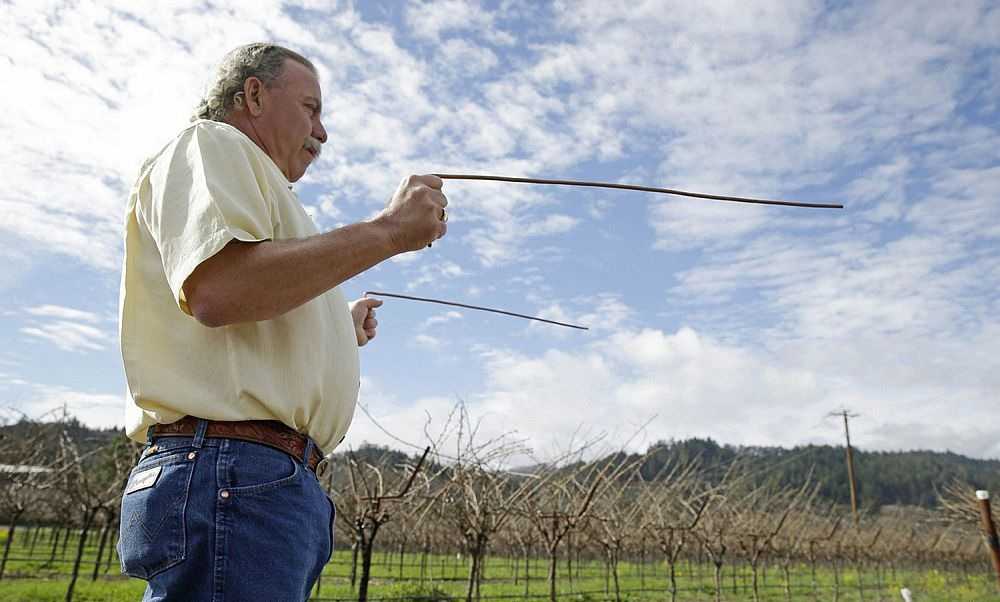
Thus, the three Arab states, Egypt, Syria and Jordan, again formed troops on the border with Israel. In the six-day war, you occupied the Sinai Peninsula, the Gaza Strip, the entire Western Jordan, the then Jordanian East Jerusalem and part of Syria. There was a shooting between Jordan and Syria, which wanted to help Arafat. But from this war, Israel won again. After these numerous wars in the region, Israel was demoralized. Gradually, Israel again withdrew and created a security zone as a kind of buffer zone against terrorist attacks.
Search for water in the area with the help of biolocation - the framework
Taking the frames in both hands, the ends of the wires are bred in opposite directions (by 180 °) and they walk around the site, observing their condition. Somewhere the frames will converge together, somewhere to turn in one direction (to the right or to the left - along the course of the water). Here on these movements and determine where the water is.
Another terrorist organization, Hissballa, tried to establish itself in the south of Lebanon and attacked the Israeli population. This has not subsided yet. On the other hand, in the second war in the Persian Gulf, Israel played no role, although Iraq once shot down the Scud missiles in Tel Aviv and its environs. This sequence of historical events shows how unstable this region of the world is in political cohesion. Israel is an absolute outsider and still does not like to be a legitimate state in the region.
If the frames came together (at some angle their ends shifted), in this place there is water. After going further you will see that the frames have again parted - the aquifer has ended. Repeat the maneuver can be from different directions and points, so you can localize the location of the water-carrier. If the two frames converge at the back pass - you have determined the place where you need to dig a well or. If the frames have deviated to the right or to the left, one must go to that side and look for a place where they will converge again.
Again and again, conflicts with neighboring countries are threatening, and there is a constantly ongoing series of terrorist attacks. Without the heavy military force of Israel, this state will no doubt no longer exist. Israel and the Palestinians: The Palestinians are increasingly being suppressed during this long period. They were originally removed from the country, but there is still a clear division between Israel and the Palestinian autonomous regions. However, as almost every day to read and hear, they are responded to by the Israeli military with attacks on the resettlement of Palestinians and other targets.
If the frames are fixed - there is no water on the site or the water-carriers are very deep.
Use of a vine (a wooden slingshot)
You can find water on the site with the help of a slingshot from a tree. You need to find two branches that grow from one point. Branches should be thick, at least 1 cm, even. Try to find them the same thickness. Cut with a piece of trunk (15-20 cm), on which they grew. Should be a big slingshot. The leaves are cleaned, the thin ends of the rods are cut off, leaving at least 40 cm and each side of the "fork". The branches are bent to the sides so that the angle is at least 150 °, fix them in this position and leave to dry. The wood may not be completely dry, but the angle should be preserved.
Thus, the conflict between the two peoples is the largest and the last. Palestinians not only take away, but also are important sources of water. Since then, Palestinians are not allowed to drill wells, but only to receive water from higher layers. The supply of water that Israel has made is often not taken into account. Thus, the Israeli settler has 130 liters of water, and the Palestinians - only 40 liters. The pipeline system was also replaced by Israeli occupation forces in the west of Jutland, if not at all, which means that much water is still lost.
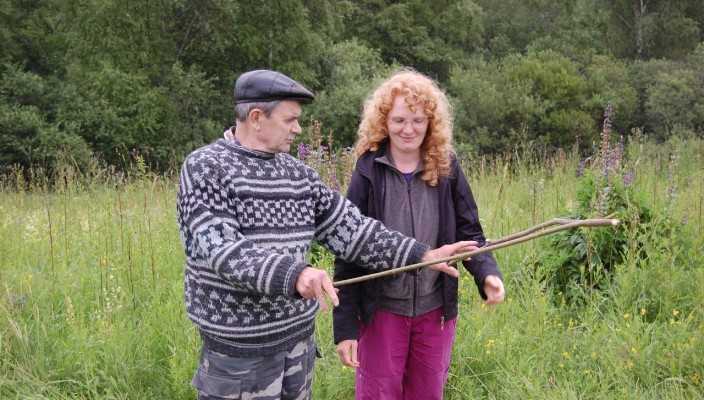
How to find water on the site with your own hands - this is how they work with the vine
The dried vine is taken for the ends of the fork, keep it horizontally at shoulder level. In the place where there is water under the earth, part of the trunk will lean towards the ground. In this place it will be possible to drill a well. If there are no deviations, there is no water in the area at a shallow depth.
As a result, the Palestinians do not have enough water for their own supplies, which also affects agriculture and food. The water problem as a whole: in the region between Israel and among other states of the League of Arab States around the water is a kind of "cold war". Large rivers, such as Yarmuk and, above all, the Jordan, are taken wherever they go, so that water can be diverted, and other states are absent. As a result of the ever-growing population and, consequently, the consumption of water, it is increasingly likely that water conflicts will arise between the Arab States, as well as Israel and the Palestinians.
Determination of the amount of water in an underground source
In addition to finding water, it would be nice to determine also its volumes. Approximately, they can be estimated using clay pots and silica gel. They take clay pots, fill them with silica gel, tie the neck with cotton cloth. Packed pots are weighed (weight can be written on the pot itself). Harvested shells are buried in places where it is supposed to find water and leave for a day.
The Nile, the Euphrates and the Tiger, as well as Jordan, are geographic points of conflict. Problems in the future can be solved only if these parties go to the negotiating table, which can be difficult in an already unstable political situation. Then there must be a fair distribution of water and new technical methods, they need to manage the water as effectively as possible to exploit it without using it. History, especially in this region of the Earth, often shows that sooner or later it will seek a military solution.
The day after the pots are excavated and re-weighed.

That pot, which is more than the others scored in weight, and notes the vein with the most water.
Searching for water - watching the nature
You can find water on the site simply by observing nature. You probably noticed that in some places the fog is the thickest. Sometimes it even resembles a river - wriggling stretches in some direction. At such points, groundwater is usually the closest. Another morning should look at the amount of dew. If in places where the fog was especially dense, there is more of it, then the water there is definitely there.
Overview of the country in the Middle East. Geohydrology considers underground waters suitable for consumption as a useful mineral, but unlike other minerals, groundwater is the only mineral that is depleted during operation.
To extract water from the subsoil, in most cases it must be pumped, and sometimes by gravity, transported or removed from the well manually in the most primitive areas. When water is extracted by pumps, there are always difficulties, as the permeability of the surrounding rocks is not large enough to allow water to flow into the well at a sufficient speed to always maintain the same level.
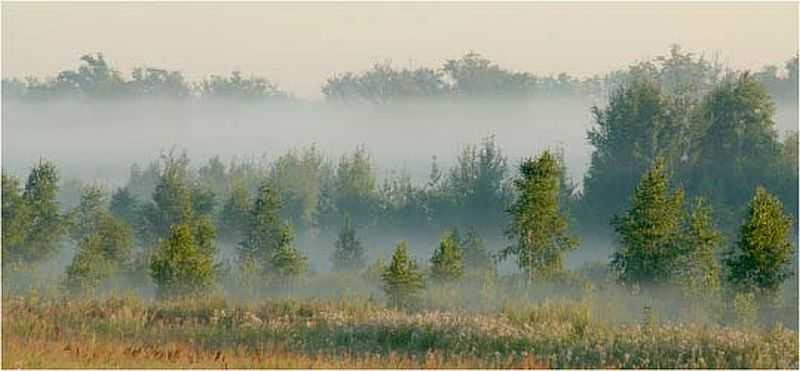
What else can help to find water on the site is the observation of insects. In a warm, windless evening, often a midwife gathers in clouds or poles. And they are located in certain places. Under places of accumulation of insects, water sources are usually located. If you look at the ground and do not find ant nests, then there really is water - the ants do not make their nests above the water.
Underground waters have laminar motion, and this is tested at reduced speeds; This laminar flow of groundwater through the rocks is called percolation. The percolation rate varies directly with the hydraulic gradient and is inversely proportional to the permeability.
The magnitude of the drop in the groundwater table is related to the permeability and extraction rate using permeability measures of rocks located near or around the well. The method determines the height of the groundwater table with different extraction rates.
How to determine the level of groundwater
Approximately to estimate, on what depth there is a verkhovodka, it is possible on growing plants above it. As can be seen from the table above, certain plant species normally feel themselves if the water is not higher and not below a certain depth. So you can approximately estimate how deep the water is.
In some areas, there is no need to dig wells, because water rises to the surface of the earth, which is caused by its internal pressure. These types of springs are known as artesian wells. For coastal areas, the process of pumping out water is difficult, because fresh water can cause coastal sediments to combine with salt water.
Fresh water usually is above salty water because of its lower density and with decreasing fresh water contact causes a rise, although an additional flow of fresh water from higher areas of the inner surface will result in contact. The assessment of natural resources and groundwater resources is of great importance, since its knowledge can be used to solve some geohydrological problems, such as determining the rate of water exchange, the age of groundwaters and estimating underground runoff in rivers and oceans, among others.
![]()
For sites where there is a natural reservoir - a river, a lake nearby - you can determine the depth of the water to the nearest meter. This will require a barometer. With him you go down to the water, you measure the pressure. Then go to the alleged source of water and measure the pressure there. The difference is usually expressed in tenths and every tenth (0.1) equates to a meter of depth. For example, the difference in measurements is 0.7 mm / Hg. post. This means that the water is at a depth of 7 meters.
What else can help to find water on the site? Communicate with neighbors who already have a well or a well. They want to know where they drilled / dug, how many times, a lot of water or not, at what depth is the mirror of water, what is its quality. At the location of all the nearest successful and unsuccessful attempts at neighbors, it is possible with a fairly high degree of probability to determine where you have water.
Life in a private house, or rather the inability to connect to a centralized water supply system, forces landowners to seek alternative solutions to the issue. The most popular ways to supply the farm with water is to dig a well in the area or to drill a well.
Well - a good choice for extracting life-giving moisture
But it is the latter that have become most widespread due to certain circumstances and advantages. The only actual question for the average private trader is price. How much will the well cost if its cost directly depends on the depth of drilling? And what is the quality of the water in it?
Selecting the location for the well
The choice of the location for the well is based on the geology of the site, the features of its terrain, and the analysis of adjacent areas. The depth of the well for water and the quality of the produced liquid depend on the aquifers lying in the earth's thickness.
To collect information and study the site should specialists from licensed firms that have permission to perform such works. But each owner, who is going to drill a well in his well, it is necessary to know some criteria for choosing a place. So, it is forbidden to drill near:
- cemeteries;
- natural garbage dumps;
- agricultural fields treated with herbicides and nitrate fertilizers;
- industrial plants and factories, etc.

Trial drilling will help to study the soil and understand at what depth the aquifer lies
How to measure the depth of a well? In the process of site investigation, trial drilling is performed to study the composition of the soil and determine the depth at which the aquifer lies. For each specific case, this is individual. For two neighbors, the depth of the wells can be different.
To determine whether water from the source reaches drinking or technical sources, it is sent for inspection to the laboratory. The analysis will show the amount of impurities, bacteria, ammonia, metal, insoluble substances, toxins and so on.
Aquifers
To answer the question - on what depth to drill a well, it is necessary to understand the diversity of aquifers and their features.
There are three main aquifers, from which water is withdrawn for hygiene and economic needs:
- Depth of vadose fluctuates within 4-7 meters. Due to the lack of a stable waterproof layer, this water is mainly used for technical needs, irrigation. From this layer water often goes cloudy, with sand and other impurities.
- The depth of groundwater is 10-18 meters, but can be much higher. Used in everyday life and drinking water is often taken from this vein. Groundwater, passed filters in the well, have a higher quality than the well. However, this does not exclude the presence of harmful and dangerous impurities in it. Water from any aquifer should be checked for compliance with the requirements of SES in special licensed laboratories.
- The third aquifer is artesian water. There is no exact information on the depth of the natural reservoir of artesian water. It is generally believed that the bedding depth varies between 25-40 meters, but can go up to 60 meters. Much depends on the terrain. Water from the third aquifer, called natural, is the cleanest and most useful.
Classification of wells
The depth of the well for drinking water determines the type to which the facility belongs.
In accordance with the three aquifers, three types of wells are distinguished:
On the sand
Used auger drilling to the first along the drill of the aquifer. The usual depth of the well on the sand is 15-30 meters. The construction itself is a long pipe with a cross section of 10 cm. At the end, the pipe is perforated and wrapped in a fine mesh net of galloon weave. The filter is installed in a bed of coarse sand.
The well's debit in the sand, that is, the volume of extracted water per unit of time, is about 0.5-1.2 m³ / h. The life of this type of well is quite small - 5-10 years in case of permanent use. If you drill it in a non-residential dacha or in a house with seasonal living, the device will become unusable in 2-3 years.
Artesian
Wells on limestone can reach 100 meters in depth. The purpose of drilling is to reach a layer of porous aquifer that carries very pure drinking water. The latter passes natural mineralization, and therefore is healthy. It is a long closed casing, so that the perpendicular does not get inside, and a perforated filter for liquid intake.
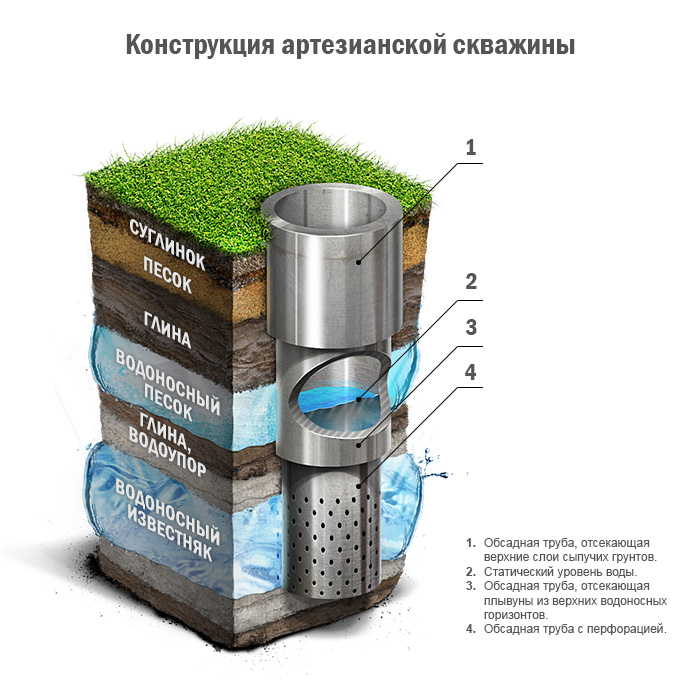
The yield of an artesian well within 3-10 cubic meters per hour. This means that in your area the water will not disappear for the next 60-70 years even under the most severe droughts. The only drawback is the high cost. Often, for the sake of economy, neighbors drill wells on limestone for several houses.
Abyssinian well
The simplest and cheapest kind of wells. It is also called a "well-needle". It is a long inch pipe with a needle-shaped tip and a filter for water intake. Deepen by drilling or piling into the soil for 8-30 meters. The extraction of water takes place with the participation of a pump that does not lift water from a depth of more than 8 meters. Suitable for areas with light soils without stones. The piezometric level should not exceed 8 meters.
How to know the depth of a well?
To know the depth of the water, conduct research work with trial drilling. It also happens that several visits are required until an aquifer is found.
If you arrange on your own site is not an artesian well, but an Abyssinian well or on the sand, start a log of records. This is necessary to fix the indicators for all stages of work on the well:
- notes on the change in rocks at a fixed depth;
- the depth of the perch;
- depth of occurrence of ground layers of a liquid;
- depth of soil washout;
- the rate of absorption of the circulating fluid, etc.
The aquifer (if it is not an artesian well) consists of loose fine sand, on both sides fenced with dense loam and clay. If the drill has reached the vein, it is impossible to stop the work. It is necessary to go deeper by 1-2 meters from the beginning of the layer with water, and take the liquid itself for expert examination.
After completion of drilling and installation of the structure, the water should be inspected for six months every month. If no changes are recorded during this time, you can safely use the water further.
Outcomes
Owners of private houses by law have the right to extract on their own plots of any minerals, including water. Legislating, without having to prepare documentation and take a permit, everyone has the right to dig a well or drill a well for five meters.
But now you are aware of how to know the depth of water in the thickness of the earth, and therefore you understand that five meters is not enough. At your own peril and risk, you can drill a well without permission. But then be ready, that one day a check will come and write out a fine. Therefore, secure yourself - get permission and take water from the layers deeper.


